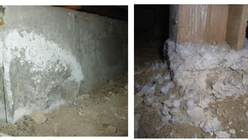Effect of water content on concrete properties

The most important parameter affecting the physical and chemical structure of concrete is the amount of water in it. The most important factor determining the strength and consistency of concrete is the W/C ratio. The amount of water found to be added to the concrete in the concrete calculation has two main tasks. One of them is the amount of water required for hydration and the other is the amount of water for workability. However, the water required for workability loses its importance after placing the concrete in the mold. Although some of this amount of water is excreted by perspiration, some of it remains trapped between the aggregate particles and evaporates in the future, causing capillary spaces to form there.
If the entire volume between the aggregate particles is filled with cement paste and if more water is added to the concrete mix than necessary, the hardened concrete becomes completely waterproof. However, since this is not possible, the voids formed will decrease the compressive strength of the concrete and adversely affect the durability of the concrete against repeated external effects. If the W/O ratio is too high in the calculations, it should be preferred to use super plasticizers so that there is no decrease in concrete compaction. Again, in the opposite case, if this ratio is too low, this situation should be overcome by adding additives. Because although the decrease in the amount of water seems good, the concrete with low workability cannot settle well after pouring into the mold and hollow concrete is produced. Therefore, water calculation is the most important factor to be considered in concrete.
It would be correct to describe the field concrete where the application is most used, as the concrete designed to have sufficient strength and durability to carry the expected moving and stationary loads in areas subject to heavy usage loads. Compared to other elements, field concrete has two important functions. Field concrete is a part of the building carrier system. The structure maintains its carrier feature as long as it is in service. It is part of the field user tools. There are user vehicles on the field concrete and there is a certain amount of traffic load.
Field concrete stages can be listed as follows: The required minimum thickness must be determined. It is important to make site preparations such as homogeneous, compacted subgrade, no puddles on the floor, giving the required slope for drainage, laying a polyethylene cover under the concrete to prevent water absorption, placing the mesh reinforcement according to the cover after the formwork. Material and labor planning is done so that there is no disruption. Appropriate placement and compaction of concrete is also among the critical points. It is necessary to perform the surface hardening process after the polishing process. Control joints are left to prevent cracks caused by shrinkage in concretes with large surface area.
Field concretes can be exposed to problems such as cracking due to shrinkage, abrasion, impacts, acid-base exposure, permeability, high temperature effect, freeze-thaw effect and surface dusting. Many of these problems are caused by low compaction. For this, our first goal should be to produce as impermeable concrete as possible.














Comments